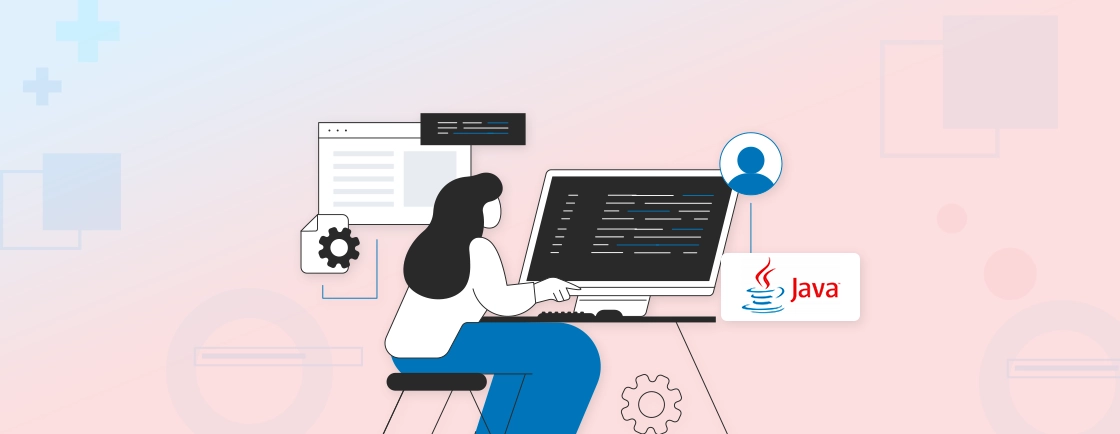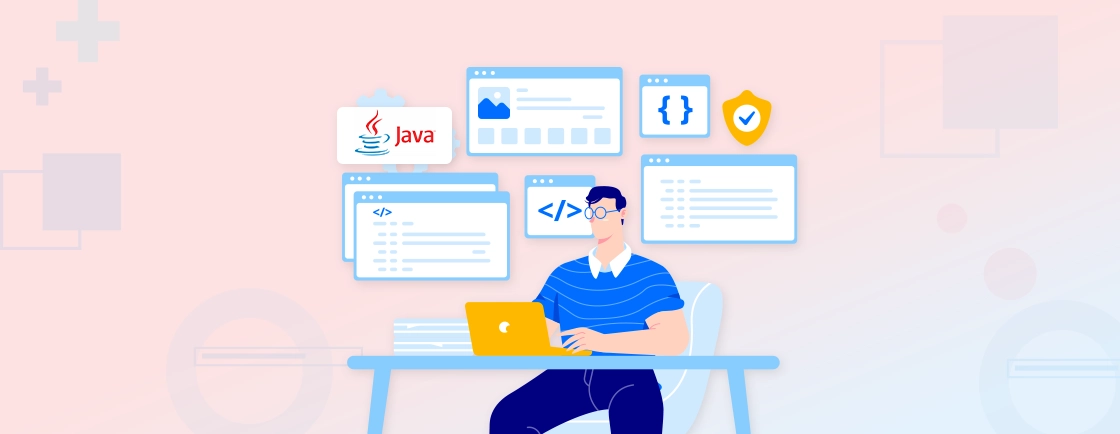Table of Contents
Did you know billions of devices are powered by Java worldwide? But why? From smartphones to enterprise servers, Java is one of the most versatile and popular programming languages in existence. It’s best capability: Write once, run anywhere.
Still, there’s a chance you are wondering, “What is Java Used for?”. Well, this robust language was initially conceived for interactive television. But now, it powers Android applications, enterprise-level software, big data processing, and much more.
Through this blog, I’ll explain the basics of Java, its features, and pros and cons. And of course, we’ll see what the Java experts use this language and platform for. Let’s begin.
Top Features of Java
Java’s enduring popularity stems from a robust set of features that have made it a cornerstone of software development for decades. Here are some of its top features:
Platform Independence (Write Once, Run Anywhere – WORA)
Java’s bytecode, executed by the Java Virtual Machine (JVM), allows applications to run on any operating system that supports a JVM. This eliminates the need to rewrite code for different platforms, significantly enhancing portability.
Object-Oriented Programming (OOP)
Java’s OOP principles (encapsulation, inheritance, polymorphism, abstraction) promote modularity, reusability, and maintainability of code. This structure simplifies complex software development and fosters cleaner, more organized code.
Robustness
Java’s strong memory management, automatic garbage collection, and exception handling minimize errors and crashes. This makes it a reliable choice for mission-critical applications.
Security
Java’s built-in security features, such as bytecode verification and security managers, protect against malicious code and unauthorized access. This is crucial for applications dealing with sensitive data.
Simple and Familiar
While powerful, Java’s syntax is relatively easy to learn, especially for those with a C/C++ background. This accessibility has contributed to the widespread adoption of the Java programming language.
Multithreading
Java’s support for multithreading allows concurrent execution of multiple tasks within a single program. This enhances performance and responsiveness, particularly in applications requiring parallel processing.
High Performance
Although interpreted, the JIT (Just-In-Time) compiler converts bytecode into native machine code at runtime, significantly improving performance.
Large and Active Community
Java programming language benefits from a vast and active community, providing extensive support, resources, and libraries. This makes it easy to find solutions and learn from experienced developers.
Extensive APIs and Libraries
Java offers a rich set of APIs and libraries for various tasks, including networking, database connectivity, and GUI development. This accelerates development and reduces the need to write code from scratch.
For businesses needing custom solutions built on Java’s powerful features, our Java Web Development Company offers expert services to bring your ideas to life.
What is Java Used for?
Java’s versatility has cemented its place in several areas of software development. Let’s discuss the primary applications of this platform.
Android Mobile Applications
Java has played a pivotal role in the development of Android mobile applications since the platform’s inception. Lately, Kotlin has become the preferred language for new Android development. But the Java programming language still remains deeply embedded within the Android ecosystem.
How It’s Used
- Developers use the Android Software Development Kit (SDK) and frameworks like Android Studio to build apps, the official integrated development environment (IDE) for Android development.
- Java APIs provide access to device features like cameras, GPS, and sensors.
- Libraries like Retrofit (networking), Glide (image loading), and Room (database management) simplify development.
- Java’s multithreading capabilities ensure smooth performance for resource-intensive apps like games and streaming platforms.
- The has historically relied heavily on Java libraries, providing developers with the tools necessary to create Android applications.
Even with the transition to Kotlin, a deep understanding of Java programming language remains valuable for Android developers, especially when working with existing codebases or integrating with Java libraries.
Web Applications
Java is a powerhouse for building scalable and secure web applications. Frameworks like Spring and Hibernate simplify development by providing tools for dependency injection, database integration, and security.
Java’s ability to handle high traffic and complex business logic makes it a favorite for enterprise-level web applications. For example, platforms like LinkedIn, Amazon, and eBay rely on Java for their backend systems. JavaServer Faces (JSF) and Apache Struts are also popular for creating dynamic web interfaces.
Java Servlet and JavaServer Pages (JSPs) are foundational technologies for building Java web applications. Servlets handle the business logic, while JSPs manage the presentation layer, allowing for dynamic content generation.
How It’s Used
- Developers use Java EE (Enterprise Edition) to build server-side applications.
- Frameworks like Spring Boot enable rapid development of RESTful APIs and microservices.
- Java’s integration with databases (e.g., MySQL, Oracle) and tools like Apache Tomcat ensures seamless backend functionality.
- Popular websites like LinkedIn and Amazon rely on Java runtime environment for their backend systems.
Java’s combination of performance, security, and a mature ecosystem makes it a powerful and versatile language for developing a wide range of web applications.
Big Data
Java plays a critical role in the big data ecosystem. Tools like Apache Hadoop and Apache Spark, which are used for processing and analyzing massive datasets, are written in Java.
How It’s Used
- Java is the backbone of big data tools like Apache Hadoop, Apache Spark, Apache Kafka, and Apache Cassandra.
- Developers use Java to write MapReduce programs for processing and analyzing massive datasets.
- Java’s integration with distributed computing frameworks enables efficient data storage and retrieval.
- Its multithreading capabilities ensure high performance in real-time data processing.
Apache Hadoop, a core framework for distributed storage and processing of large datasets, is primarily written in Java. Its MapReduce programming model, which allows for parallel processing of data, is often implemented using Java.
Apache Spark’s in-memory processing capabilities and support for various data processing tasks, such as batch processing, streaming, and machine learning, make it a powerful tool for big data analytics.
Apache Kafka, a distributed streaming platform, is also written in Scala and Java. Its ability to handle high-throughput, real-time data streams makes it essential for applications requiring continuous data ingestion and processing.
Although Apache Cassandra is written in Java, it is a NoSQL database that is used for handling large amounts of data across many commodity servers, providing high availability with no single point of failure.
Cloud-based Applications
Java’s platform independence and scalability make it a top choice for cloud-native development. It is widely used in cloud platforms like Google Cloud, Amazon Web Services (AWS), and Microsoft Azure.
Java’s ability to run on virtual machines (VMs) and containers (like Docker) ensures seamless deployment and management of cloud applications.
How It’s Used
- Developers use frameworks like Spring Cloud to build microservices and deploy them on cloud platforms.
- Java’s integration with containerization tools like Docker and orchestration tools like Kubernetes ensures seamless scalability.
- Java-based applications are used for SaaS (Software as a Service) platforms, cloud storage, and serverless computing.
Microservices architectures, which are central to modern cloud development, are often built using Java frameworks like Spring Boot.
Internet of Things
Java’s lightweight versions, such as Java ME (Micro Edition), are designed for embedded systems and IoT devices. Its ability to run on low-power devices with limited resources makes it suitable for smart appliances, wearables, and sensors.
How It’s Used
- Java is used to program smart devices like wearables, sensors, and home automation systems.
- Frameworks like Eclipse IoT and Oracle IoT Cloud simplify IoT application development.
- Java’s ability to handle real-time data processing makes it suitable for IoT applications in healthcare, agriculture, and smart cities.
For example, Java is used in smart home devices like thermostats and security systems, as well as in industrial IoT applications for monitoring and automation. Java’s platform independence ensures that IoT solutions can be deployed across diverse hardware environments.
Desktop GUI Applications
Java’s Swing and JavaFX libraries enable developers to create cross-platform desktop applications with rich graphical user interfaces (GUIs). These libraries provide tools for designing interactive and visually appealing applications.
How It’s Used
- Developers use JavaFX to build modern, interactive desktop applications with features like 3D graphics and multimedia support.
- Tools like IntelliJ IDEA and Eclipse provide robust environments for desktop app development.
- Java is used to create applications like IDEs, financial software, and productivity tools.
Pros & Cons of Java
Java is one of the most widely used programming languages, known for its versatility, robustness, and platform independence. However, like any technology, it has its advantages and disadvantages.
Pros of Java
Platform Independence
Java’s “write once, run anywhere” (WORA) capability allows code to run on any device with a Java Virtual Machine (JVM). This makes Java highly portable across operating systems like Windows, macOS, and Linux.
Object-Oriented Programming (OOP)
Java’s OOP principles, such as encapsulation, inheritance, and polymorphism, promote modular, reusable, and maintainable code, making it ideal for large-scale projects.
Rich Standard Library
Java’s extensive libraries and frameworks, such as Java Standard Edition (SE) and Java Enterprise Edition (EE), provide pre-built tools for tasks ranging from data structures to networking, reducing development time.
Strong Community Support
Java has one of the largest and most active developer communities, offering abundant resources, tutorials, and third-party tools for learning and troubleshooting.
Robust and Secure
Java’s strong memory management, exception handling, and built-in security features, like bytecode verification and sandboxing, make it a reliable choice for building secure applications.
Multithreading and Concurrency
Java supports concurrent execution of multiple threads, enabling efficient handling of tasks and improving performance in applications like gaming and real-time systems.
Scalability
Java’s architecture supports the development of scalable applications, making it ideal for enterprise-level systems and cloud-based solutions.
Automatic Memory Management
Java’s garbage collection automatically manages memory allocation and deallocation, reducing the risk of memory leaks and enhancing application stability.
Backward Compatibility
Java ensures backward compatibility, meaning older versions of Java applications can run on newer JVMs without modification.
Wide Range of Applications
Java is used in diverse domains, including mobile apps, web development, big data, IoT, and enterprise software, making it a versatile language.
Cons of Java
Performance Overhead
Java’s reliance on the JVM and garbage collection can lead to slower performance compared to natively compiled languages like C or C++.
Verbosity
Java is known for being verbose, requiring more lines of code to accomplish tasks compared to languages like Python or Ruby. This can increase development time.
Memory Consumption
Java applications tend to consume more memory due to the JVM and runtime environment, which can be a drawback for memory-constrained systems.
Less Suitable for Low-Level Programming
Java is not ideal for low-level system programming or applications that require direct hardware interaction, as it abstracts many system-level details.
Learning Curve
While Java is beginner-friendly, its extensive libraries, frameworks, and concepts like multithreading and OOP can be overwhelming for new developers.
Limited Support for Functional Programming
Although Java introduced functional programming features in Java 8 (e.g., lambda expressions), it is still primarily an object-oriented language and lags behind languages like Scala or Kotlin in this regard.
Slower Startup Time
Java applications often have a slower startup time due to the initialization of the JVM and runtime environment.
Cost of Commercial Licenses
While Java itself is free, some enterprise tools and features (e.g., Oracle JDK for commercial use) require paid licenses, which can increase costs for businesses.
Less Control Over Garbage Collection
Although garbage collection simplifies memory management, developers have limited control over it, which can lead to performance issues in real-time systems.
Outdated GUI Frameworks
Java’s GUI frameworks, such as Swing and JavaFX, are considered outdated compared to modern frameworks for desktop application development.
Java’s strengths, such as platform independence, robustness, and scalability, make it a top choice for a wide range of applications. However, its performance overhead, verbosity, and memory consumption can be drawbacks in certain scenarios.
Is Java Better Than Python?
The answer to the question of whether or not Java is better than Python depends on the context, as both languages have their strengths and weaknesses. They are designed for different purposes and excel in different domains.
Let’s compare them briefly.
Performance
Java is generally faster than Python because it is a compiled language (to bytecode) and runs on the Java Virtual Machine (JVM). Its performance is closer to lower-level languages like C++.
Python, on the other hand, is an interpreted language, which makes it slower than Java. However, for many applications, the difference in speed is negligible.
Winner: Java for performance-critical applications.
Ease of Learning and Use
Java has a steeper learning curve due to its verbose syntax and strict object-oriented programming (OOP) principles. Beginners may find concepts like classes, inheritance, and multithreading challenging.
Python, on the flip side, is known for its simplicity and readability. Its syntax is concise and intuitive, making it one of the easiest languages to learn, especially for beginners.
Winner: Python for ease of learning and use.
Syntax and Readability
Java requires more lines of code to accomplish tasks, making it more verbose. For example, even a simple “Hello, World!” program requires a class and method definition.
On the other hand, Python’s syntax is clean and concise, often requiring fewer lines of code. This makes Python code easier to read and write.
Winner: Python for readability and simplicity.
Use Cases and Applications
Java is used for:
- Mobile apps (Android development)
- Enterprise applications (banking, CRM systems)
- Web applications (backend development with Spring)
- Big data (Hadoop, Spark)
- IoT (embedded systems)
Python, on the other hand, is used for:
- Data science and machine learning (TensorFlow, PyTorch)
- Web development (Django, Flask)
- Scripting and automation
- Scientific computing (NumPy, SciPy)
- Prototyping and rapid development
Winner: Java for enterprise and mobile apps; Python for data science and scripting.
Community and Ecosystem
Java has a massive, mature ecosystem with extensive libraries, frameworks (e.g., Spring, Hibernate), and tools. It also has strong community support and is widely used in enterprise environments.
Python’s ecosystem, on the flip side, is equally robust, with a focus on data science, machine learning, and web development. Its community is very active, and it has a wealth of libraries like Pandas, NumPy, and TensorFlow.
Winner: Tie – Both have strong ecosystems, but they cater to different domains.
Scalability
Java is highly scalable, making it a preferred choice for large-scale enterprise applications and distributed systems.
However, Python can also scale, but it is often used for smaller projects or as a prototyping tool. For large-scale systems, additional tools and frameworks are required.
Winner: Java for scalability in enterprise systems.
Scalability
Java is highly scalable, making it a preferred choice for large-scale enterprise applications and distributed systems.
Python, on the other hand, can also scale, but it is often used for smaller projects or as a prototyping tool. For large-scale systems, additional tools and frameworks are required.
Winner: Java for scalability in enterprise systems.
Platform Independence
Java’s “write once, run anywhere” (WORA) capability allows it to run on any device with a JVM, making it highly portable.
Python is also cross-platform, but it requires an interpreter to be installed on the target system.
Winner: Tie – Both are platform-independent, but Java’s JVM offers a slight edge in portability.
Speed of Development
Java’s verbosity and strict syntax can slow down development, especially for smaller projects.
On the other hand, Python’s concise syntax and dynamic typing enable rapid development and prototyping.
Winner: Python for faster development cycles.
Security
Java has built-in security features like bytecode verification and sandboxing, making it a secure choice for enterprise applications.
On the other hand, Python is also secure but may require additional libraries and practices to achieve the same level of security as Java.
Winner: Java for built-in security features.
Both Java and Python are powerful languages, and the choice depends on your specific project requirements and career goals.
FAQs on What Java is Used for
Is Java difficult to learn?
Like any programming language, Java requires time and effort to learn. However, its relatively simple syntax and extensive resources make it accessible to beginners.
What is the difference between Java and JavaScript?
Java and JavaScript are distinct programming languages. Java is a compiled, object-oriented language, while JavaScript is an interpreted scripting language primarily used for web development. They share a similar name, but that is where the similarity ends.
Is Java used for mobile app development?
Yes, Java was historically the primary language for Android app development. While Kotlin is now preferred, many existing Android apps are still written in Java.
Let’s Conclude
Java’s enduring presence across diverse technological landscapes underscores its fundamental strength: adaptability. From the bedrock of Android applications to the complex architectures of enterprise systems and the massive data processing of big data, Java’s reliability and platform independence continue to be vital.
While the tech world evolves, Java’s mature ecosystem and robust features ensure its continued relevance, offering developers a solid foundation. So they can build scalable and dependable software solutions.
To build reliable and scalable Java applications, you can hire Java programmers from our experienced team dedicated to your success.
Strengthen Your Java Solutions
Dive into comprehensive tutorials and best practices to enhance your Java development skills.





